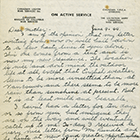Witnessing the war through a camera lens
August 26, 2015
Hugh McCaughey was in his mid-thirties and working in a camera store in Vancouver when he signed up for the Canadian Film and Photo Unit (CFPU) in 1942. Before the war was over, he would travel to England, France, Holland and Germany, recording both combat and activity behind the lines.
All the while, he took photographs of life in camp (including a now well-known photograph of a young war artist named Alex Colville) and kept meticulous records of his work in his photo log and his diaries. He even saved the short cine clips that the film processors in Britain would send back so that he could check exposures. After processing, his work would be screened by censors and newsreel makers and flown to Canada for the movie theatres.
Images for posterity
“The CFPU had the responsibility to film and photograph Canadians at war — including combat situations,” says Carol Reid, Collections Specialist at the Canadian War Museum. “Their footage has created many of the images that define the war for Canadians to this day. Thanks to Sergeant McCaughey, we now have a chronicle of the circumstances in which many of these images were created.”
A witness to D-Day
Each week, Sergeant McCaughey wrote long letters home — some 215 of them to family and friends — describing the perils faced by combat cameramen. Just after D-Day, for example, he described to his mother how, after being dropped behind the German lines with a paratroop unit, one of his comrades fought his way through to get his film footage back to the Allies.
On D-Day, he himself filmed the wounded and prisoners being returned to Britain. “I photographed the English casualties,” he wrote, “and they gave me the impression of being completely broken in spirit, but not the Canadians. They laugh and smile and as orderlies [helped] a Canadian from the boat, he continued to crack jokes and was eager to answer my questions.”
Combat cameramen
A cameraman would go into combat carrying small arms. In addition to knowing how to fight if necessary, he also had to be a skilled technical expert, a roving reporter, a salesman and, at times, a diplomat able to relate to everyone from a private in the field to a high- ranking officer at headquarters — all in the interest of getting the camera shot that would tell the story for the people back home.
A valuable collection
After the war, Sergeant McCaughey brought his notebooks, cine clips and photos with him when he returned to the Vancouver camera store. His family and friends had saved his letters. Now the entire collection has been donated to the Canadian War Museum, where they tell the story of how the CFPU contributed to the Allied victory — sometimes by taking great risks to secure images that are now the foundation of how many Canadians think of the war.
“The Museum has some collections from war correspondents such as Mathew Gillespie Cowan and Ben Malkin, and we do have photographs from other CFPU members,” says Reid, “but this is the first time we have had documents such as letters and diaries by a cameraman. We plan to use this valuable material in an upcoming exhibition on war and media.”
Top: Letter from Sgt. McCaughey, CWM 20140022-002_06-09-44_p1–4 George Metcalf Archival Collection, Canadian War Museum
Bottom: Sergeant Hugh McCaughey, CWM 20140022-002-003 George Metcalf Archival Collection, Canadian War Museum
